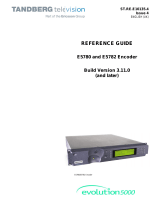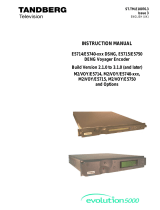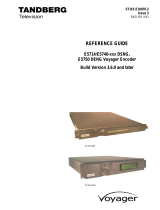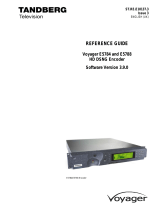
SM6630 and SM6635 Satellite Modulators
20
Top Level Sub-level Description
Gold Seq N: 0 – 262141 (available only when
Standard is set to DVB-S2)
Roll-off: 20%, 25%, 30%, 35%
IF Frequency: 50 – 180 MHz for model SM6630;
950 – 1750 MHz for model SM6635
Uplink Freq: 10.070000 GHz (value related to IF
Frequency, dependent upon UpConv Freq and IF
Spectrum – see note below)
IF Power: −20 to 5 dBm
IF Output: OFF, ON
Mod. State: OFF, ON
IF Spectrum: Normal, Inverted
IF Tilt: −0.04 dB/MHz to 0.04 dB/MHz
UpConv Freq:
0.000000 – 100.000000 GHz
UpConv Pwr: OFF, ON (available only on model
SM6635)
UpConv Ref: OFF, ON (available only on model
SM6635)
=PREKOR Menu= (available only with the
PREKOR software option)
Change
Configuration
Allows changes to the current configuration
settings as a block of changes:
Data Select: ASI1, ASI2, Null Pkts, PRBS
Packet Size: Unframed, 188 bytes, 204 bytes
Rate Adapt: OFF, ON
Bit Rate: 1 – 84 Mbit/s (variable limits, dependent
upon selected Packet Size, Modulation, FEC
Rate and other parameters)
Symbol Rate: 1 – 5 Msymbol/s
(0.1 – 48 Msymbol/s with 48 MSym/s option or
0.1 – 66 Msymbol/s with 66 MSym/s option)
Standard: DVB-S/DSNG (+ DVB-S2 with S2
software option)
Modulation: BPSK, QPSK, 8PSK, 16QAM,
16APSK, 32APSK (available values dependent
upon software options installed and selected
Standard)
FEC Rate: 1/4, 1/3, 2/5, 1/2, 3/5, 2/3, 3/4, 4/5,
5/6, 7/8, 8/9, 9/10 (available values dependent
upon selected Standard, Modulation and Frame
Size)
Frame Size: Normal, Short (available only when
Standard is set to DVB-S2)






























